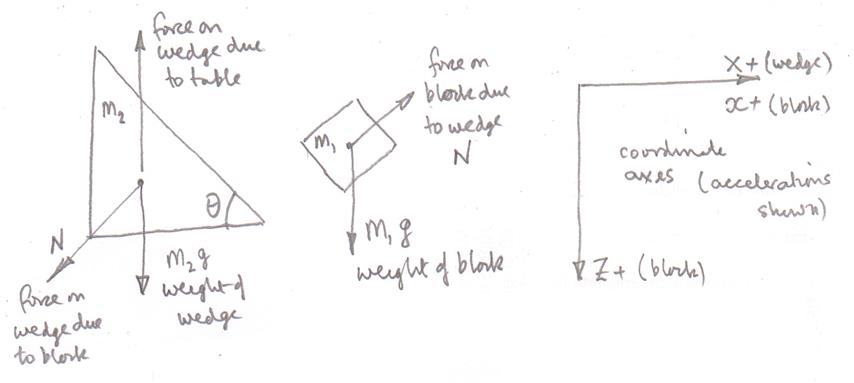Rather than answer your individual questions I will give you an overview and then discuss some of the points that you have raised.
There are many ways of tackling such problems but drawing a few FBDs together with some coordinate axes is always a good to start.

I will use the laboratory frame of reference as it is perhaps then easier to describe what one sees from that reference frame and I will further assume that there is no friction and that everything starts from rest.
The other important assumption for the first part of the analysis is that the block and the wedge stay in contact with one another.
Newton's second law can then be applied which will yield equations with the vertical and horizontal accelerations of the block, $z$ and $x$, the horizontal acceleration of the wedge $X$ and the normal reaction between the block and the wedge $N$ as the four unknowns.
The problem is that application of Newton's second law only yields three equations.
As with a lot of mechanics problems the fourth equation comes from the geometry of the system.
The block keeps in contact with the wedge and relative to the wedge it slides down the wedge at an angle $\theta$.
That is, if you sit on the wedge you will see the block accelerating down the wedge but staying in contact.
The downward acceleration of the wedge relative to the block is $z$ (the wedge has no downward movement as the table is assumed immoveable) and the horizontal acceleration of the block relative to the wedge is $x-X$.
The acceleration vector diagrams looks like this:

It yield the fourth equation $\tan \theta = \dfrac{z}{x-X}$
I hope that this is sufficient to answer all your questions?
The wedge has to go left and the block towards the right.
This must be so in that the net horizontal force on the block-wedge system is zero and so the centre of mass of the system does not move.
Using this idea one can get a equation linking the horizontal acceleration of the block $x$ and that of the wedge $X$ directly; $(m_1\;x + m_2 \; X = 0 +0 \Rightarrow X = - \dfrac {m_1\; x}{m_2} $.
If for some reason the acceleration of the wedge to the left is greater than $X$ in the example above, eg due to an external horizontal force on the wedge acting to the left, then the situation becomes more complicated.
Assume that the force is such that the horizontal acceleration of the wedge to the left stays constant with a magnitude $Y$.
The normal force between the wedge and the block will decrease so downward acceleration of the block $z$ will increase whereas its horizontal acceleration of the4 block $x$ will decrease but it will still stay in contact with the wedge.
In the acceleration diagram remembering that because the acceleration of the wedge is to the left the magnitude of $x-Y$ will increase as will the magnitude of $z$ to ensure that the block stays in contact with the wedge.
So if you sit on the wedge you will see the block staying in contact with the wedge but with a greater acceleration downwards than before.
Sitting in the laboratory frame you again will see the wedge accelerating faster down the wedge but with a trajectory whose angle with the horizontal is greater than the angle of the wedge $\theta$.
The limiting case is reached when the downward acceleration of the block is $g (= z) $ and its horizontal acceleration $x$ is zero.
So in this limiting case $\tan \theta = \dfrac{g}{(-)Y}$
Any further increase in the horizontal acceleration of the wedge to the left will result in the block losing contact with the wedge and undergoing free fall.
I am not entirely sure about the last part of the analysis but the limiting acceleration $Y$ formula seems to predict what one might expect.
As the angle $\theta$ gets smaller and smaller to keep just in contact with the block the horizontal acceleration of the wedge $Y$ has to get bigger and bigger whereas as the angle $\theta$ tends towards $90 ^\circ$ the acceleration of the wedge $Y$ has to get smaller and smaller.



